
The Royal Logistic Corps provides logistic support functions to the British Army. It is the largest Corps in the Army.

The Adjutant General's Corps is a corps in the British Army responsible for many of its general administrative services. As of 2002, the AGC had a staff of 7,000 people.

The Royal Corps of Transport (RCT) was a British Army Corps established to manage all matters in relation to the transport of men and material for the Army and the wider Defence community. It was formed in 1965 and disbanded in 1993; its units and trades were amalgamated into the Royal Logistic Corps. The Depot and Training Regiment RCT was at the former Buller Barracks in Aldershot garrison.

The Royal New Zealand Army Logistic Regiment , is the New Zealand Army's main military Logistics and combat service support (CSS) element. It is the largest regiment in the NZ Army.

ANZUK was a tripartite force formed by Australia, New Zealand and the United Kingdom to defend the Asian Pacific region after the United Kingdom withdrew forces from the east of Suez in the early 1970s. The ANZUK force was formed in Singapore on 1 November 1971 under Rear Admiral David Wells and disbanded on 31 January 1974.

The Royal Australian Army Ordnance Corps (RAAOC) is the Corps within the Australian Army concerned with supply and administration, as well as the demolition and disposal of explosives and salvage of battle-damaged equipment. The Corps contains clerks, operator supplies, petroleum operators, parachute riggers and ammunition technicians. Members of the Corps are nicknamed Roaches.

The Logistic Regiment "Julia" is a military logistics regiment of the Italian Army based in Merano in South Tyrol. Today the regiment is the logistic unit of the Alpine Brigade "Julia" and shares with the brigade's infantry troops, the Alpini, the distinctive Cappello Alpino.
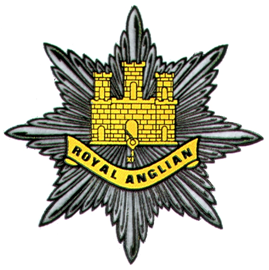
The 3rd Battalion, Royal Anglian Regiment "The Steelbacks" is the Army Reserve unit of the Royal Anglian Regiment and is made up of volunteers who train in their spare time as soldiers. It was established on 1 April 2006, it was formed from five of the six companies of the East of England Regiment with A, B, C, E and HQ companies going to 3 Royal Anglian and D Company going to the 4th (V) Battalion, Mercian Regiment.

The Home Service Force was a Home Guard type force established in the United Kingdom in 1982. Each HSF unit was placed with either a Regular Army or Territorial Army regiment or battalion for administrative purposes and given that formation’s title, cap badge and recruited from volunteers aged 18–60 with previous British forces experience. It was introduced to guard key points and installations likely to be the target of enemy special forces and saboteurs, so releasing other units for mobile defence roles. It was stood down in 1992.
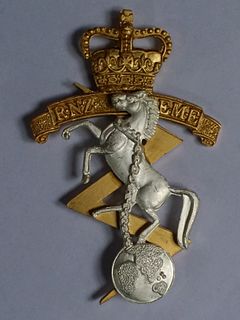
The Royal New Zealand Electrical and Mechanical Engineers (RNZEME) was a New Zealand Army Corps comprising Army trained tradesmen (craftsmen) who repaired Army equipment wherever New Zealand Forces served.
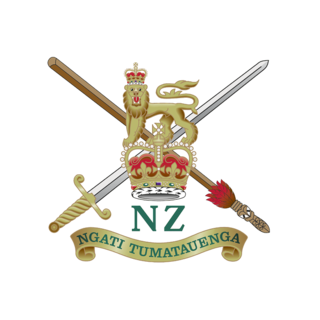
The New Zealand Intelligence Corps (NZIC) analyses information from a variety of sources and provides commanders with intelligence on such things as enemy locations, capabilities and intentions. Corps personnel also provide advice on Field Security on operations.
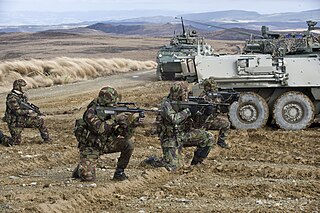
This article describes the current structure of the New Zealand Army. It includes the army's order of battle and the headquarters locations of major units.

Airborne forces raised by Australia have included a number of conventional and special forces units. During the Second World War the Australian Army formed the 1st Parachute Battalion; however, it did not see action. In the post-war period Australia's parachute capability was primarily maintained by special forces units. In the early 1980s a parachute infantry capability was revived which led to the Parachute Battalion Group forming in 1983 based on the 3rd Battalion, Royal Australian Regiment. In 1997, a full time commando regiment was raised that was able to conduct large-scale operations which matured during the 2000s. In 2011, 3 RAR relinquished the parachute role with the Army deciding to opt out of a conventional parachute capability in preference to a special forces large-scale parachute capability.
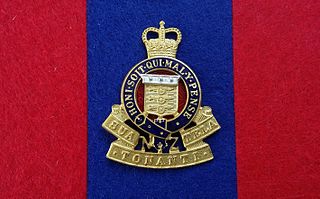
The Royal New Zealand Army Ordnance Corps (RNZAOC) concerned itself with the provisioning of troops with the means to fight; specifically uniforms, weapons and equipment. Ordnance functions go back hundreds of years; the first Ordnance Officer in the British military appeared in the year 1299. Designated "Keeper of the King's Wardrobe", his duties included the care and accounting of heavy equipment such as battering rams and catapults.
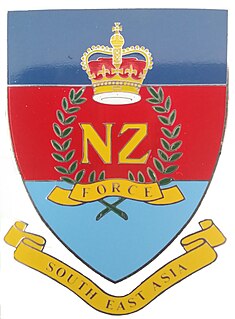
New Zealand Force South East Asia (NZFORSEA) (1974–1989) comprised the elements of the Royal New Zealand Navy, New Zealand Army and Royal New Zealand Air Force. Much of the New Zealand military left Singapore as part of operation Kupe in 1989, leaving behind a residual Defence Support Unit (NZDSU).
The ANZUK Support Group was established in 1971 to provide Transport and Supply services to Australian, New Zealand and British forces stationed in Singapore and Malaysia as part of ANZUK Force. It was commanded by a Royal Australian Army Service Corps officer and staffed by Australian, New Zealand, United Kingdom personnel and Locally Employed Civilians (LECs). This organisation operated for only a short period. Australia changed Government in 1972 and the incoming Labor Government decided to withdraw Australia’s commitment to the region. This took effect in 1974 and was followed later by the withdrawal of the British forces. It was then decided that New Zealand should form its own Transport Company, designated the New Zealand Transport Company. This was the start of a commitment which was to last until December 1989.
From four Stores Depots in the main centres of New Zealand at the beginning of the 20th century, the Royal New Zealand Army Ordnance Corps (RNZAOC) expanded and shrank to meet the operational needs of the NZ Army, Ordnance units have been deployed worldwide and across the breath and width of New Zealand.

The Logistic Regiment "Taurinense" is a military logistics regiment of the Italian Army based in Rivoli in Piedmont. Today the regiment is the logistic unit of the Alpine Brigade "Taurinense" and shares with the brigade's infantry troops, the Alpini, the distinctive Cappello Alpino.

The 3rd (Volunteer) Battalion, The Royal Regiment of Wales was an infantry battalion of the British Army, part of the Royal Regiment of Wales. The battalion was formed during the expansion of the Territorial and Army Volunteer Reserve (TAVR) in 1971, and later disbanded and merged with the 4th (V) Battalion of the same regiment to form the new 2nd (V) Battalion. The battalion's lineage is currently carried on by two company-sized units: C Company, part of the 3rd Battalion, The Royal Welsh and 580 (Glamorgan) Transport Squadron of 157th Regiment, Royal Logistic Corps.





















